 W
WAlabandite or alabandine is a rarely occurring manganese sulfide mineral. It crystallizes in the cubic crystal system with the chemical composition Mn2+S and develops commonly massive to granular aggregates, but rarely also cubic or octahedral crystals to 1 cm.
 W
WAllactite is a rare arsenate mineral of metamorphosed manganese zinc ore deposits. It is found in Sweden and New Jersey, US. Its name originated from Greek αλλάκτειν (allaktein) meaning "to change", referring to the strong pleochroism of the mineral.
 W
WAlleghanyite is a moderately rare humite mineral with formula Mn5(SiO4)2(OH)2, belonging to the nesosilicates class. In general its occurrences are related with metamorphic (metamorphosed) manganese deposits. The mineral is named after Alleghany County, North Carolina, US.
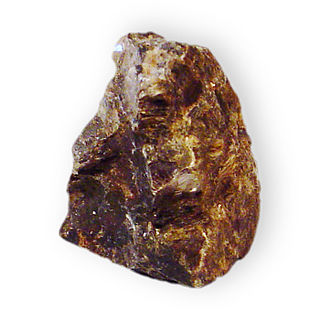 W
WAlluaudite is a relatively common alkaline manganese iron phosphate mineral with formula (Na,Ca)Mn2+(Fe3+,Mn2+,Fe2+,Mg)2(PO4)3. It occurs as metasomatic replacement in granitic pegmatites and within phosphatic nodules in shales.
 W
WAnkerite is a calcium, iron, magnesium, manganese carbonate mineral of the group of rhombohedral carbonates with formula: Ca(Fe,Mg,Mn)(CO3)2. In composition it is closely related to dolomite, but differs from this in having magnesium replaced by varying amounts of iron(II) and manganese. It forms a series with dolomite and kutnohorite.
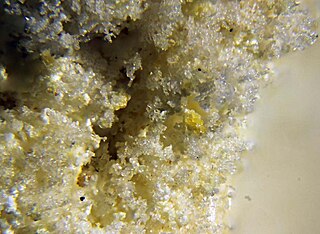 W
WApjohnite is a manganese aluminum sulfate mineral with the chemical formula Mn2+Al2(SO4)4·22H2O. It was named after Trinity College Dublin professor James Apjohn. Its type locality is Maputo Province, Mozambique.
 W
WAxinite is a brown to violet-brown, or reddish-brown bladed group of minerals composed of calcium aluminium boro-silicate, (Ca,Fe,Mn)3Al2BO3Si4O12OH. Axinite is pyroelectric and piezoelectric.
 W
WBalangeroite is found in one of the most important chrysotile mines in Europe, the Balangero Serpentinite. Hence, it is usually mistaken as an asbestiform in an assemblage of other mineral phases like chrysotile, magnetite and Fe-Ni alloys. However, Balangeroite does not lead to serious health problems caused by asbestos fibers.
 W
WCalderite is a mineral in the garnet group with the chemical formula (Mn2+, Ca)3(Fe3+, Al)2(SiO4)3.
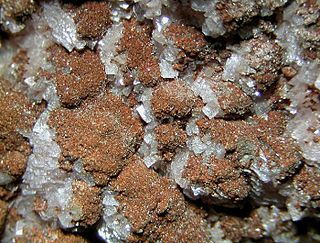 W
WCaryopilite (synonymous with ectropite and ektropite) is a brown-colored mineral with formula (Mn2+,Mg)3Si2O5(OH)4. The mineral was discovered in 1889 from a mine in Sweden. It was named for the Greek words for walnut and felt in reference to its appearance.
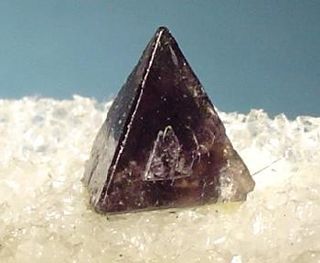 W
WChambersite is a manganese borate mineral with formula: Mn3B7O13Cl. It is a member of the borate mineral series that includes other minerals such as ericaite, Fe3B7O13Cl, and boracite Mg3B7O13Cl. When chambersite was first discovered, it was the second chemical analogue of boracite to be found in nature. It was discovered as a mineral at Barber's Hill salt dome in Texas in 1957 and in 1971 at the Dongshuichang deposit in Jixian, Tianjin, China. Chambersite occurs associated with the evaporite minerals halite, anhydrite, and gypsum.
 W
WChildrenite is a rare hydrated phosphate mineral with elements iron, manganese, aluminium, phosphorus, oxygen and hydrogen. Its chemical formula is (Fe2+,Mn)2+AlPO4(OH)2•H2O and it has a molecular weight of 229.83 g/mol. Its specific gravity is 3.2 and it has a Mohs hardness of 4.5 to 5. It is usually translucent and non-fluorescent, with imperfect cleavage. It has a vitreous lustre with a white streak, and is brown or yellow in color. It has a conchoidal, uneven fracture, and an orthorhombic crystal system.
 W
WChloritoid is a silicate mineral of metamorphic origin. It is an iron magnesium manganese alumino-silicate hydroxide with formula (Fe, Mg, Mn)2Al4Si2O10(OH)4. It occurs as greenish grey to black platy micaceous crystals and foliated masses. Its Mohs hardness is 6.5, unusually high for a platy mineral, and it has a specific gravity of 3.52 to 3.57. It typically occurs in phyllites, schists and marbles.
 W
WColumbite, also called niobite, niobite-tantalite and columbate [(Fe, Mn)Nb2O6], is a black mineral group that is an ore of niobium. It has a submetallic luster and a high density and is a niobate of iron and manganese. This mineral group was first found in Haddam, Connecticut, in the United States. It forms a series with the tantalum-dominant analogue ferrotantalite and one with the manganese-dominant analogue manganocolumbite. The iron-rich member of the columbite group is ferrocolumbite. Some tin and tungsten may be present in the mineral. Yttrocolumbite is the yttrium-rich columbite with the formula (Y,U,Fe)(Nb,Ta)O4. It is a radioactive mineral found in Mozambique.
 W
WEveite is a manganese arsenate mineral in the olivenite group. Its chemical formula is Mn2AsO4OH. It is found only in Långban, Filipstad, Värmland, Sweden and at the Sterling Mine in New Jersey, United States. It is a dimorph of sarkinite and is isostructural with adamite. The name, for the biblical "Eve", comes from its structural similarities to adamite and is also a reference to its apple-green color. It can also be pale yellow. Eveite is an orthorhombic mineral, which means it has three crystallographic axes of unequal lengths which are at 90° to one another.
 W
WFluckite is an arsenate mineral with the chemical formula CaMnH2(AsO4)2·2(H2O).
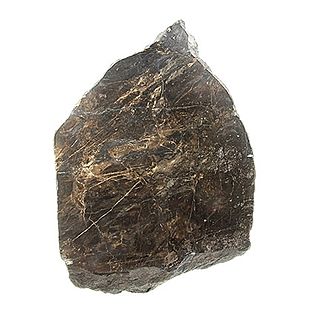 W
WGalaxite, also known as 'mangan-spinel' is an isometric mineral belonging to the spinel group of oxides with the ideal chemical formula Mn2+Al2O4.
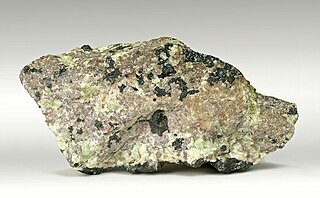 W
WGlaucochroite is a calcium manganese nesosilicate mineral with formula: CaMnSiO4. It occurs in metamorphosed limestones.
 W
WGraftonite is an iron(II), manganese, calcium phosphate mineral with the chemical formula (Fe2+,Mn,Ca)3(PO4)2. It forms lamellar to granular translucent brown to red-brown to pink monoclinic prismatic crystals. It has a vitreous luster with a Mohs hardness of 5 and a specific gravity of 3.67 to 3.7.
 W
WThe mineral hubeite, Ca2Mn2+Fe3+[Si4O12(OH)]·(H2O)2, is a sorosilicate of the Si4O13 group. Structurally it also belongs to the Akatoreite group. It was found and named after the province of Hubei, China. It is common to iron ores in a mine of that region. It occurs mainly as aggregates of fan like crystals. It is dark to pale brown, has orange-brown streak and is vitreous. Hubeite has a hardness of 5.5 in the Mohs scale, one good cleavage and conchoidal fracture. It is triclinic with a space group of P1*. The structure of hubeite is very uncommon, and in fact there is only one other mineral that fits the Si4O13 group, which is ruizite.
 W
WHübnerite or hubnerite is a mineral consisting of manganese tungsten oxide (chemical formula MnWO4). It is the manganese endmember of the manganese–iron wolframite solid solution series. It forms reddish brown to black monoclinic prismatic submetallic crystals. The crystals are typically flattened and occur with fine striations. It has a high specific gravity of 7.15 and a Mohs hardness of 4.5. It is transparent to translucent with perfect cleavage. Refractive index values are nα = 2.170 - 2.200, nβ = 2.220, and nγ = 2.300 - 2.320.
 W
WHureaulite is a manganese phosphate with the formula Mn2+5(PO3OH)2(PO4)2·4H2O. It was discovered in 1825 and named in 1826 for the type locality, Les Hureaux, Saint-Sylvestre, Haute-Vienne, Limousin, France. It is sometimes written as huréaulite, but the IMA does not recommend this for English language text.
 W
WInesite is a hydrous calcium manganese silicate mineral. Its chemical formula is Ca2Mn7Si10O28(OH)2•5(H2O). Inesite is an inosilicate with a triclinic crystal system. It has a Mohs hardness of 5.5 to 6, and a specific gravity of 3.0. Its name originates from the Greek Ίνες (ines), "fibers" in allusion to its color and habit.
 W
WJerrygibbsite is a rare silicate mineral with chemical formula: (Mn,Zn)9(SiO4)4(OH)2. Jerrygibbsite was originally discovered by Pete J. Dunn in 1984, who named it after mineralogist Gerald V. Gibbs (born 1929). It has only been reported from the type locality of Franklin Furnace, New Jersey, United States, and in Namibia's Otjozondjupa region. Jerrygibbsite is member of the leucophoenite family of the humite group. It is always found with these two minerals. It is a dimorph of sonolite.
 W
WKutnohorite is a rare calcium manganese carbonate mineral with magnesium and iron that is a member of the dolomite group. It forms a series with dolomite, and with ankerite. The end member formula is CaMn2+(CO3)2, but Mg2+ and Fe2+ commonly substitute for Mn2+, with the Mn content varying from 38% to 84%, so the formula Ca(Mn2+,Mg,Fe2+)(CO3)2 better represents the species. It was named by Professor Bukowsky in 1901 after the type locality of Kutná Hora, Bohemia, in the Czech Republic. It was originally spelt “kutnahorite” but “kutnohorite” is the current IMA-approved spelling.
 W
WLeucophoenicite is a mineral with formula Mn7(SiO4)3(OH)2. Generally brown to red or pink in color, the mineral gets its name from the Greek words meaning "pale purple-red". Leucophoenicite was discovered in New Jersey, US and identified as a new mineral in 1899.
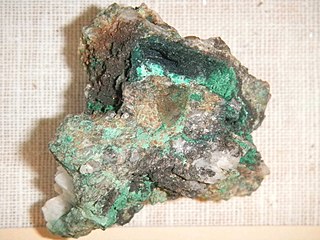 W
WLipscombite (Fe2+,Mn2+)(Fe3+)2(PO4)2(OH)2 is a green gray, olive green, or black. phosphate-based mineral containing iron, magnesium, and iron phosphate.
 W
WLithiophilite is a mineral containing the element lithium. It is lithium manganese(II) phosphate with formula: LiMnPO4. It occurs in pegmatites often associated with triphylite, the iron end member in a solid solution series. The mineral with intermediate composition is known as sicklerite (Li(Mn,Fe)PO4). The name lithiophilite is derived from the Greek philos (φιλός) "friend," as lithiophilite is usually found with lithium.
 W
WManganoan calcite or manganocalcite is a variety of calcite rich in manganese, which gives the mineral a pink color. Its chemical composition is (Ca,Mn)CO3. It was first reported from the Banská Štiavnica Mining District, Slovak Republic, but is widely distributed around the world, notably in the Cave of Swords at Naica, Chihuahua, Mexico, and in Bulgaria.
 W
WManganoeudialyte is an moderately rare mineral of the eudialyte group, with formula Na14Ca6Mn3Zr3Si2[Si24O72(OH)2]Cl2·4H2O. The formula given is one of the forms that can be given, based on the originally reported one, and shows dominance of silicon at both the M3 and M4 sites. As suggested by its name, it is the manganese-analogue of eudialyte.
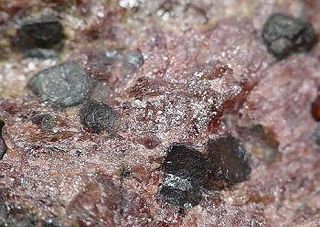 W
WManganosite is a rare mineral composed of manganese(II) oxide MnO. It was first described in 1817 for an occurrence in the Harz Mountains, Saxony-Anhalt, Germany. It has also been reported from Langban and Nordmark, Sweden and at Franklin Furnace, New Jersey. It also occurs in Japan, Kyrgyzstan and Burkina Faso.
 W
WMesselite is a mineral with formula Ca2(Fe2+,Mn2+)(PO4)2·2H2O. It was discovered in Germany and described in 1890. The mineral was subsequently discredited in 1940, reinstated and named neomesselite in 1955, and the name restored to messelite in 1959.
 W
WNambulite is a lithium bearing manganese silicate mineral with formula: (Li,Na)Mn4Si5O14(OH). It is named after the mineralogist, Matsuo Nambu (born 1917) of Tohoko University, Japan, who is known for his research in manganese minerals. The mineral was first discovered in the Funakozawa Mine of northeastern Japan, a metasedimentary manganese ore.
 W
WNatrophilite is a mineral with the chemical formula NaMnPO4. In a pure form it has a yellow coloration. Its crystals are orthorhombic to dipyramidal. It is transparent to translucent. It is not radioactive. Natrophilite is rated 4.5 to 5 on the Mohs Scale.
 W
WOttrelite is a form of chloritoid. Its empirical formula is (Mn,Fe,Mg)2Al4Si2O10(OH)4.
 W
WPyrophanite is a manganese titanium oxide mineral with formula: MnTiO3. It is a member of the ilmenite group. It is a deep red to greenish black mineral which crystallizes in the trigonal system.
 W
WPyroxferroite (Fe2+,Ca)SiO3 is a single chain inosilicate. It is mostly composed of iron, silicon and oxygen, with smaller fractions of calcium and several other metals. Together with armalcolite and tranquillityite, it is one of the three minerals which were discovered on the Moon. It was then found in Lunar and Martian meteorites as well as a mineral in the Earth's crust. Pyroxferroite can also be produced by annealing synthetic clinopyroxene at high pressures and temperatures. The mineral is metastable and gradually decomposes at ambient conditions, but this process can take billions of years.
 W
WPyroxmangite has the general chemical formula of MnSiO3. It is the high-pressure, low-temperature dimorph of rhodonite.
 W
WRhodochrosite is a manganese carbonate mineral with chemical composition MnCO3. In its (rare) pure form, it is typically a rose-red color, but impure specimens can be shades of pink to pale brown. It streaks white, and its Mohs hardness varies between 3.5 and 4. Its specific gravity is between 3.5 and 3.7. It crystallizes in the trigonal system, and cleaves with rhombohedral carbonate cleavage in three directions. Crystal twinning often is present. It is transparent to translucent with refractive indices of nω=1.814 to 1.816, nε=1.596 to 1.598. It is often confused with the manganese silicate, rhodonite, but is distinctly softer. It is officially listed as one of the National symbols of Argentina.
 W
WRhodonite is a manganese inosilicate, (Mn, Fe, Mg, Ca)SiO3 and member of the pyroxenoid group of minerals, crystallizing in the triclinic system. It commonly occurs as cleavable to compact masses with a rose-red color (the name comes from the Greek ῥόδος rhodos, rosy), often tending to brown because of surface oxidation.
 W
WSamsonite is a silver manganese antimony sulfosalt mineral with formula Ag4MnSb2S6. It crystallizes in the monoclinic crystal system with a typical slender radiating prismatic habit. It is metallic black to steel black with no cleavage and a brittle to conchoidal fracture. In thin fragments it appears reddish brown in transmitted light and also leaves a red streak. It is soft, Mohs hardness of 2.5, and has a specific gravity of 5.51.
 W
WSarkinite, synonymous with chondrarsenite and polyarsenite, is a mineral with formula Mn2(AsO4)(OH). The mineral is named for the Greek word σάρκιυος, meaning made of flesh, for its red color and greasy luster. The mineral was first noted in Sweden in 1865 as chondrarsenite, though not identified as Sarkinite until 1885.
 W
WSeamanite, named for discoverer Arthur E. Seaman, is a rare manganese boron phosphate mineral with formula Mn3[B(OH)4](PO4)(OH)2. The yellow to pink mineral occurs as small, needle-shaped crystals. It was first discovered in 1917 from a mine in Iron County, Michigan, United States and identified in 1930. As of 2012, seamanite is known from four sites in Michigan and South Australia.
 W
WSerandite is a mineral with formula Na(Mn2+,Ca)2Si3O8(OH). The mineral was discovered in Guinea in 1931 and named for J. M. Sérand. Serandite is generally red, brown, black or colorless. The correct name lacks an accent.
 W
WShigaite is a mineral with formula NaAl3(Mn2+)6(SO4)2(OH)18·12H2O that typically occurs as small, hexagonal crystals or thin coatings. It is named for Shiga Prefecture, Japan, where it was discovered in 1985. The formula was significantly revised in 1996, identifying sodium as a previously unknown constituent.
 W
WSonolite is a mineral with formula Mn9(SiO4)4(OH,F)2. The mineral was discovered in 1960 in the Sono mine in Kyoto Prefecture, Japan. In 1963, it was identified as a new mineral and named after the Sono mine.
 W
WSpessartine, sometimes mistakenly referred to as spessartite, is a nesosilicate, manganese aluminium garnet species, Mn2+3Al2(SiO4)3. The mineral spessartine should not be confused with a type of igneous rock (a lamprophyre) called spessartite.
 W
WSwitzerite is a mineral with the chemical formula of (Mn)3(PO4)2·7H2O. The mineral was named after George Switzer, former Curator of Minerals at the US National Museum.The mineral is monoclinic prismatic, meaning that it has one mirror plane, one 2-fold rotation axis which is perpendicular to the mirror plane and a center of symmetry. Switzerite is a part of the monoclinic space group P 21/a. For its optical properties, Switzerite is classified as anisotropic, has a low surface relief and birefringence of δ = 0.020.
 W
WThe mineral group tantalite [(Fe, Mn)Ta2O6] is the primary source of the chemical element tantalum. It is chemically similar to columbite, and the two are often grouped together as a semi-singular mineral called coltan or "columbite-tantalite" in many mineral guides. However, tantalite has a much greater specific gravity than columbite (8.0+ compared to columbite's 5.2). Iron-rich tantalite is the mineral tantalite-(Fe) or ferrotantalite and manganese-rich is tantalite-(Mn) or manganotantalite.
 W
WTapiolite [(Fe, Mn)(Nb, Ta)2O6] is a black mineral series that is an ore of niobium and tantalum. The tapiolite group includes tapiolite-(Fe) or ferrotapiolite and tapiolite-(Mn) or manganotapiolite. Tapiolite-(Fe) is by far the more common of the two.
 W
WTephroite is the manganese endmember of the olivine group of nesosilicate minerals with the formula Mn2SiO4. A solid solution series exists between tephroite and its analogues, the group endmembers fayalite and forsterite. Divalent iron or magnesium may readily replace manganese in the olivine crystal structure.
 W
WTitanowodginite is a mineral with the chemical formula MnTiTa2O8. Titanowodginite has a Mohs hardness of 5.5 and a vitreous luster. It is an iridescent dark brown to black crystal that commonly forms in a matrix of smoky quartz or white beryl in a complex zoned pegmatite.
 W
WTriplite is a rare phosphate mineral with formula: (Mn,Fe)2PO4(F,OH). It occurs in phosphate-rich granitic pegmatites typically as irregular brown opaque masses. Triplite was first described in 1813 for an occurrence in Chanteloube, Limousin, France. The name is from the Greek triplos for triple, in reference to the three cleavage directions. In color and appearance, it is very similar to rhodocrosite, another manganese bearing mineral. Chemically, it is also quite similar to triploidite the difference being that triplite is fluorine dominant while triploidite is hydroxide dominant.
 W
WTriploidite is an uncommon manganese iron phosphate mineral with formula: (Mn,Fe)2PO4OH. It crystallizes in the monoclinic crystal system and typically occurs as elongated and striated slender prisms which may be columnar to fibrous. Its crystals may be pinkish to yellowish brown or red-orange.
 W
WWhiteite is a rare hydrated phosphate mineral, with hydroxyl
 W
WWolframite, (Fe,Mn)WO4, is an iron manganese tungstate mineral that is the intermediate between ferberite (Fe2+ rich) and hübnerite (Mn2+ rich). Along with scheelite, the wolframite series are the most important tungsten ore minerals. Wolframite is found in quartz veins and pegmatites associated with granitic intrusives. Associated minerals include cassiterite, scheelite, bismuth, quartz, pyrite, galena, sphalerite, and arsenopyrite.
 W
WZakharovite is a mineral, a silicate of sodium and manganese; formula Na4Mn5Si10O24(OH)6·6H2O. It has a yellow colour with a pearly lustre. Discovered in 1982 in the Kola peninsula of Northern Russia, it is named after Evgeny Evgenevich Zakharov (1902–1980), the director of the Moscow Institute of Geological Exploration.
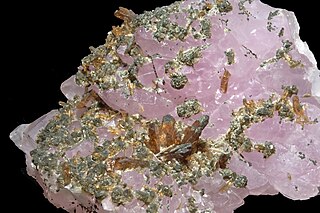 W
WZanazziite is a complex hydrated phosphate mineral from the roscherite group. It is a magnesium beryllium phosphate mineral. Zanazziite arises as barrel-shaped crystals and can reach up to 4 mm. It grows alongside quartz minerals. It is found in the crevices of Lavra da Ilha pegmatite, near Taquaral, in northeastern Minas Gerais, Brazil. Zanazziite is named after Pier F. Zanazzi. Zanazziite has an ideal chemical formula of Ca2Mg5Be4(PO4)6(OH)4·6H2O.